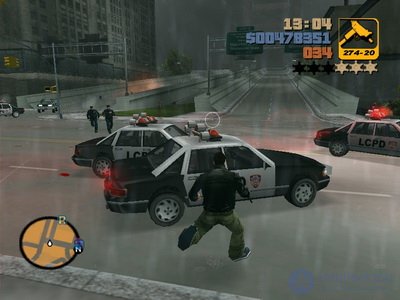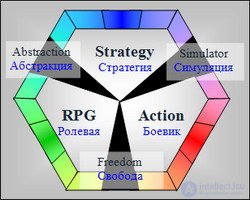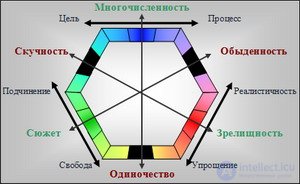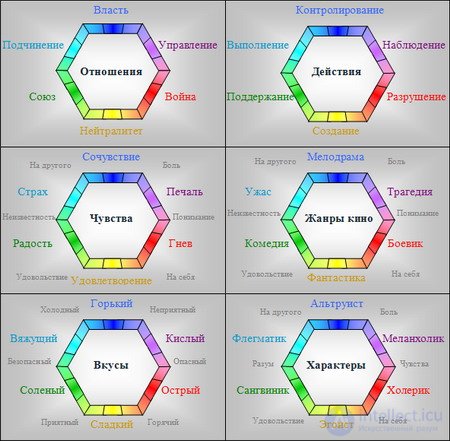| |
 |
| What is the genre of the game GTA? |
|
|
The emergence of game genres
Computer games originated in the 50s of the last century (more than 60 years ago), and game genres appeared only 20 years ago.
At the initial stage of development of the gaming industry, each game was unique and inimitable. But over time, the games became more and more. In order to navigate in all the variety of games, people began to divide the game into different categories.
The criteria for the division into categories were very different: the number of players, the type of game camera, the plot (for more details on all types of game classification in the article “Classification of computer games”). But the most popular was the method of division into game genres.
The genres of games were formed without structure and intuitively for a long time. Game developers carried out bold experiments, creating new game mechanics. Unsuccessful experiments were forgotten, and successful games became an example for other developers. The developers copied the popular game mechanics, adding a few ideas from themselves, so around the most popular games formed whole classes of similar games, these classes began to be called game genres.
The division into genres is very useful in practice. Games of a particular genre are interesting for an already formed gaming audience. The developer announces that he is releasing the game in a certain genre, and the players are already approximately aware of what will happen in the game, even without specifying developer comments.
| |
 |
| What is the genre of the game DotA? |
|
|
The problem of unstructured genres
We know how to call the most popular genres, we know how they differ from each other. But there is still no complete and clearly structured classification of computer games genres:
- about many games there are doubts about their genre affiliation (which genre is “Grand Theif Auto” (GTA), “Defender Of The Ancient” (DotA)?);
- different sources call the same genres by different names (“3D-shooter”, “3D-Action”, “FPS”, “TPS”, “Action”, “Action”);
- all types of games are sometimes called various simulators (“Action” - “soldier simulator”, “Strategy” - “commander simulator”, “Team action” - “tactical simulator”).
However, many of the game critics can not even clearly explain their classification.
Yes, everything is very confusing and ambiguous, many say that a clear classification of computer games is in principle impossible. Computer games are works of art, they know no boundaries (in this case, genres act as boundaries), it often happens that the game contains signs of almost all genres, and in such proportions that it is really not clear what kind of genre is for it. This is true. But genres themselves are simple structures, and it would be time to systematize them long ago.
Scheme of genres
On our website gamesisart.ru was created the most complete classification of games by genre - a unique scheme of its kind genres of computer games. (The details of creating a scheme can be found in a separate article “
Classification of computer game genres (for researchers) ”).

A detailed description of the entire table as a whole, and of each genre in particular, can be found here:
The structure of the scheme of genres
If you see this diagram of genres for the first time, its complexity may frighten you. It's okay, now let's figure it out together. The scheme contains all commonly used game genres that are known to most players, only they are arranged so that they form a clear structure. Let's get acquainted with the logic of this structure.
The whole scheme is divided into 15 vertical bars. 15 bands are grouped into 3 large groups of games - “Information Games”, “Action Games”, “Control Games”. At the bottom of each band is its essence - the base (indivisible) genre, which can be called in one word. All names of entities: learning, riddles, communication, hero, exploring the world, collecting, evading, destroying, competition, technique, care, development, microcontrol, tactics, planning.
On top of the names of entities (basic game mechanics) are the genres themselves in the form of rectangles. The simplest genres are at the bottom, they occupy only one lane. The higher the genre is, the more bands it has. The occurrence of a block of the genre at once in several lanes means that several basic game mechanics are present at once, united in a single whole. (For example: the “Quest” genre is an association of two basic classes “Riddles”, “Communication”).
How to use the scheme of genres
The scheme, located on the “Table of genres” page, is interactive. You can click on a block of any genre, then you will see a detailed description of the genre. After viewing the details, you can press the “Backspace (<-)” key and you will return to the diagram view. (For those who still can not orient on the scheme, all genre names are duplicated in the form of a simple text numbered list below).
Classification of genres (for researchers)
Are you interested in how the genre scheme described above was invented? Want to know what logic is embedded in it? All ingenious is simple. And to be a genius, you need to see patterns where ordinary people see only an accidental combination of circumstances. Begin the search for patterns ...
Justification of the structure of the scheme of genres
Decomposition into elementary particles
From the initial data we have only historically formed genres. We place their names on the same plane, and try to determine from the ready-made copies what system of coordinates they are in.
We take the actions most frequently performed in games of this genre as the main criterion for dividing genres (camera position: view from the eyes, rear view, view from the top, view from the cockpit; movement of time: real time or step-by-step mode; number of players - not are criteria for genres, they only determine the way the gameplay is presented).
We begin the preparation of each genre, in the hope of expanding it into smaller parts. It is necessary to have a great gaming experience in the respective genres in order to understand what they consist of.
Grouping, coordinate system
All found elementary particles of genres are located on the line, and use them as a coordinate system.
By the method of selection we group all particles into three subgroups: role-playing, shooters, strategies. All games within the group are very similar to each other, but at the same time there are games with various deviations. Sometimes deviations are small, and sometimes very significant. Such far away from the reference (for the group) games become completely different from their ideological ancestors, but they are still inside the group. So the groups of games themselves are much wider than their reference representatives. Standards are in the middle of the middle, and games with increasing deviations are farther from the center.
Extreme boundaries were found in each group. And when the boundaries are found, the group is easier to give the correct name, easier to divide into separate parts. As a result, all genres were successfully qualified for three initial large groups, each large group was divided into five equal elements lying in the same plane. The result was a beautiful, perfectly built table consisting of fifteen elementary genres. And surprisingly, according to this table you can easily classify any game at all, and not just a computer game. Board and courtyard, and television, and educational games are classified.
The following three names were given to three large groups of games:
- Communication games.
Basic actions: obtaining information, communication, exploring the world.
- Action Games.
Basic actions: moving in space, using weapons and equipment.
- Game control.
Basic actions: command, control, distribution of material resources.
Game palette

We develop the idea further. Found elementary particles of genres can be presented in a different form for greater clarity. We use the analogy with a circular palette of colors. To do this, we place elementary genres not in a straight line, but in a circle.
Each element is assigned its own color so that we get an RGB palette. For convenience, we divide the solid circle into 6 faces: three primary colors - green, red, blue; and three composite colors — yellow, purple, blue-green.
Each of the faces of the hexagon is divided into three genres, resulting in 18 components. But elementary game genres were found only 15, where are the other three? These three components exist, but are not elementary genres, on the contrary, they are just that, against which all kinds of games are created. They are the boundaries that divide the games into three broad categories. All 15 game genres have already been reviewed. Consider the anti-game components.
Anti-game elements
Dullness
At the junction of role-playing games and strategies is the edge "abstraction". This is the complete opposite of the "action films", which are struggling with "boring" with the help of entertainment.
For games of this face is characterized by sketchiness, restriction of freedom, lack of realism, and lack of entertainment.
On the part of strategies in abstractions, the main thing is the fulfillment of the “goal”.
From the role-playing games - "submission."
The result is obedience to someone else's goals, ie doing boring work. At the same time, completely new events may occur that have never happened before, but during these events you will still have to submit to someone else's will (this is the main difference from the other element - “routine”). The central point of the element is slavery and unqualified execution of orders. This has nothing to do with games.
 About bydnost
About bydnost .
At the junction of strategies and militants is the edge of "simulation." This is the exact opposite of "role-playing games" that struggle with the "ordinariness" of an interesting "plot."
For games of this face, imitation of real processes, restriction of freedom, lack of novelty and complete lack of plot are typical.
On the part of strategies in simulations, the “process” itself becomes the main thing.
On the part of the militants - "realistic" what is happening on the screen.
The result is a realistic imitation of the process, that is, ordinary life. At the same time, there are several events that are constantly occurring, and apart from them there is nothing else, nothing new appears. The central point of the element is not used, since complete realism is unattainable in games, and who needs an exact, 100% copy of reality, if it already exists in life.
Oh loneliness .
At the junction of role-playing games and militants is the edge of "freedom." This is the exact opposite of “strategies”, which oppose the “large number” of subordinates at disposal to “loneliness” (Strategies, of course, do not struggle with loneliness in the usual sense, but they imitate power - the most pleasant type of communication).
For games of this face, large open spaces, lack of simulator realism, lack of novelty, lack of control over other participants are characteristic.
On the part of role-playing games in the “games of freedom”, the main thing is the absence of ready-made role-playing connections, the possibility of independent choice, that is, “role-playing freedom”.
On the part of the militants - "simplification" of real events and processes, compared with simulators.
The result is role-playing freedom in a simplified model of the real world. The freedom of one being ends where the freedom of another begins, so the most extreme point of freedom is total loneliness. The most extreme point of simplification is an empty world, freedom in space. The action that has the greatest freedom is the creation of something completely new. The result is the central point of the element: complete loneliness in an empty world in which you can create - a level editor. Directly during the game, the editing capabilities are not used, but there are separate elements of the creation process in games.
It is easy to understand from this hexagon: what is most important in certain types of games, between what the game developers have to compromise, what should not be in games in any way, what can be confused with each other, what cannot be mixed.
In the picture, different genres are depicted in different colors, smoothly flowing into each other. This is not by chance. This hexagon of genres is a real palette for creating games. The same palette as the artists of fine art.
Justification of the choice of colors for the edges of the scheme
Edge " abstraction ".
It embodies the
submission and learning, getting new information. New means
fresh . Most often, in abstract (casual) games,
new types of gameplay,
new ideas are tested for the first time, and only when players like it - is the novelty distributed to other genres. On the part of role-playing games, information is converted into training, which implies the
submission of the player, that is, his
passivity . The center of the brink - excessive
abstraction of games (the center of the brink) drives melancholy, therefore it is not used in games.
Face " role ".
The basis of this facet is
interaction with other characters, a fascinating story and receiving information.
Friendly communication takes up most of the gameplay.
 The brink " freedom ."
The brink " freedom ."
This line includes arcade action games, characterized by increased
vigor of the gameplay. The center of the brink is loneliness. This loneliness is not forced, but conscious, and there is nothing bad in it. With other characters easier and more fun, on the one hand, you can
promote them, you can
resist . All this takes time and effort, so the most
productive activity will be completely alone. But since the player cannot
create anything from scratch in games, the center of the face is not used in games, but is used when
creating them.
The brink " thriller ."
The main component of all games of this edge is
aggression . And
aggression and the
danger associated with it are always associated with
red . And the
blood abounding in action movies has the same color. The closer to the arcade, the brighter the
emotions , the brighter and brighter the color. The closer to simulator, the more
restrained aggression, the duller and darker the color.
The brink " simulation ."
This includes the simulation of vehicles, the simulation of
everyday life, and sports and economic games that are close to the simulation. All these simulations consist of two simple actions, mixed in equal proportions -
observation and control. In such games they are very
meticulous about small, insignificant details. The center of the verge is complete
realism and almost
indifferent observation of the process —
melancholy , which is always associated with
violet . The center of the verge (full
realism ) is not used in games.
The brink " strategy ."
This includes management games. The main occupation in the game becomes
rational disposal of controlled objects: troops or entire armies, cities or whole countries. In such games, it is important
cold calculation,
control of the situation. The closer to simulator, the weaker and more inconvenient control becomes, the more it turns into
realistic control. The closer to abstraction, the easier the control, the more it turns into
schematic planning.
Palette analogies
The resulting palette in the form of a regular hexagon is universal. With the help of this figure, many things can be broken into elements: firstly, the color itself, sunshine, tastes, characters, feelings, relationships, while there will be an analogy in color and meaning. It seems that most of the world has been created from this threefold dualism.

Game classification
Genres are successfully classified. There are 15 main elements of which any game consists. Now you can classify computer games themselves by their elementary composition.
Let us examine for example a very complex genre composition of the game.

Take the "
Space Rangers ".
1. In the game there is a small introductory training, we note the "training" in the diagram.
2.3 The game has quests both in text form and in the form of simple tasks, we note “quests” (“riddles” + “communication”).
4. Role elements are present: there are characteristics, there are classes of characters, we note the “role”.
5. The study of the world, on this and built most of the game, role-playing freedom is. We note the "study of the world."
6. Freedom is not from the first person, actions are not so free, it means that there is no “overcoming” element.
7. There are few evasions (you can only escape from battle, you cannot be evaded during battle, but in battles in hyperspace there is an “arcade action” (“evasion” + “destruction”)).
8. In normal battles there is the usual "destruction", we note it.
9. Competition is present: there are other rangers who perform the same tasks as the player; among all the rangers, statistics are kept and there is a pedestal of honor. Celebrate "competition."
10. "Simulation technology" is missing.
11. “Planning” exists: there is a global map and the player can choose for himself which star to win now, which later.
12. "Tactics" is also there: you can hire up to four assistants.
13. "Microcontrol" is not.
14. There is a “development”: a good economic system, a lot of goods, where to spend money, you can upgrade your ship, you can build new space stations, you can order military operations.
15. "Care" is not.
As a result, we see that “Space Rangers” are mostly “Open RPG” with the addition of “Action” and small elements of “control games”.

Take "
The Godfather 2, As a bright representative of GTA-like games. (The Grand Thief Auto game itself is a bit simpler in terms of genre composition, so we will not consider it).
1. Initial "learning" is.
2. "Mysteries" no.
3. There is no free "communication", it is only in the screensavers.
4. There are small “role-playing” elements: subordinates with different professions, but the hero himself has nothing like that.
5. Role freedom is not.
6. But there is freedom in space (three cities) and actions.
7. “Evade” in principle is possible, but there is no need.
8. "Destruction" - the basis of the game.
9. "Competition" is present: enemy families do not sit still, but act just like a player.
10. "Simulation technology" is, but very primitive.
11. There is a “Planning”: you can choose which buildings to capture, which ones to protect more, which ones to throw on the drift.
12. "Tactics" is: up to three guards can be taken with you, but in general there can be up to seven of them.
13. There was an attempt to make a “microcontrol”, but it did not succeed: the fighters who do not go with the hero, but separately leave for tasks and the seizure of buildings.
14. There was also an attempt to make “development” (“economy”), but it also failed: each building brings money, certain bonuses; but money is not needed, they can be spent only on the characteristics of the fighters and weapons, which in turn change little.
15. "Care" is absent.
As a result, we see that “The Godfather 2” is an “Open Action” (open world action) with a small addition of “planning” and “tactics”.
In the analyzed examples, we see that this classification is more complex than the usual notation in one or two words. But, in contrast to the unconscious definition of the genre, based only on the personal experience of the player, this method is more scientific and accurate. Using the table of genres significantly reduces the chance of an error occurring during the genre positioning of the game. In addition, this method of determining the genre most fully conveys the essence of complex and multifaceted games.

 We develop the idea further. Found elementary particles of genres can be presented in a different form for greater clarity. We use the analogy with a circular palette of colors. To do this, we place elementary genres not in a straight line, but in a circle.
We develop the idea further. Found elementary particles of genres can be presented in a different form for greater clarity. We use the analogy with a circular palette of colors. To do this, we place elementary genres not in a straight line, but in a circle. About bydnost .
About bydnost . The brink " freedom ."
The brink " freedom ."
 Take the " Space Rangers ".
Take the " Space Rangers ". Take " The Godfather 2, As a bright representative of GTA-like games. (The Grand Thief Auto game itself is a bit simpler in terms of genre composition, so we will not consider it).
Take " The Godfather 2, As a bright representative of GTA-like games. (The Grand Thief Auto game itself is a bit simpler in terms of genre composition, so we will not consider it).
Comments
To leave a comment
Computer games developming
Terms: Computer games developming